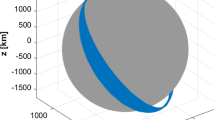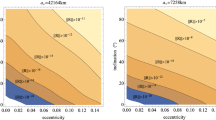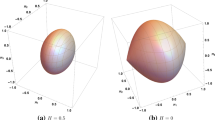Abstract
A novel approach for the exact Delaunay normalization of the perturbed Keplerian Hamiltonian with tesseral and sectorial spherical harmonics is presented in this work. It is shown that the exact solution for the Delaunay normalization can be reduced to quadratures by the application of Deprit’s Lie-transform-based perturbation method. Two different series representations of the quadratures, one in powers of the eccentricity and the other in powers of the ratio of the Earth’s angular velocity to the satellite’s mean motion, are derived. The latter series representation produces expressions for the short-period variations that are similar to those obtained from the conventional method of relegation. Alternatively, the quadratures can be evaluated numerically, resulting in more compact expressions for the short-period variations that are valid for an elliptic orbit with an arbitrary value of the eccentricity. Using the proposed methodology for the Delaunay normalization, generalized expressions for the short-period variations of the equinoctial orbital elements, valid for an arbitrary tesseral or sectorial harmonic, are derived. The result is a compact unified artificial satellite theory for the sub-synchronous and super-synchronous orbit regimes, which is nonsingular for the resonant orbits, and is closed-form in the eccentricity as well. The accuracy of the proposed theory is validated by comparison with numerical orbit propagations.






Similar content being viewed by others
References
Aksnes, K.: A second-order artificial satellite theory based on an intermediate orbit. Astron. J. 75(9), 1066 (1970). https://doi.org/10.1086/111061
Aksnes, K.: A note on ‘the main problem of satellite theory for small eccentricities, by A. Deprit and A. Rom, 1970’. Celest. Mech. 4(1), 119–121 (1971). https://doi.org/10.1007/BF01230328
Battin, R.H.: An Introduction to the Mathematics and Methods of Astrodynamics. AIAA Education Series, Reston (1987)
Breiter, S.: Second-order solution for the zonal problem of satellite theory. Celest. Mech. Dyn. Astron. 67(3), 237–249 (1997)
Brouwer, D.: Solution of the problem of artificial satellite theory without drag. Astron. J. 64(1274), 378–396 (1959). https://doi.org/10.1086/107958
Cefola, P.J.: A recursive formulation for the tesseral disturbing function in equinoctial variables. In: AIAA/AAS Astrodynamics Conference, AIAA/AAS Astrodynamics Conference, pp. 76–839 (1976). https://doi.org/10.2514/6.1976-839
Cefola, P.J., McClain, W.D.: A recursive formulation of the short-periodic perturbations in equinoctial variables. In: AIAA/AAS Astrodynamics Conference, AIAA/AAS Astrodynamics Conference, pp. 78–1383 (1978). https://doi.org/10.2514/6.1978-1383
Coffey, S.L., Alfriend, K.T.: Short period elimination for the tesseral harmonics. In: Proceedings of Advances in the Astronautical Sciences, AAS/AIAA Astrodynamics Specialist Conference, Lake Tahoe, vol. 46, pp. 87–101 (1981)
Coffey, S.L., Alfriend, K.T.: An analytic orbit prediction program generator. J. Guid. Control Dyn. 7(5), 575–581 (1984). https://doi.org/10.2514/3.19897
Coffey, S.L., Deprit, A.: Third-order solution to the main problem in satellite theory. J. Guid. Control Dyn. 5(4), 366–371 (1982). https://doi.org/10.2514/3.56183
Deprit, A.: Canonical transformations depending on a small parameter. Celest. Mech. 1(1), 12–30 (1969). https://doi.org/10.1007/BF01230629
Deprit, A.: Delaunay normalizations. Celest. Mech. 26, 9–21 (1982)
Deprit, A., Palacián, J., Deprit, E.: The relegation algorithm. Celest. Mech. Dyn. Astron. 79(3), 157–182 (2001). https://doi.org/10.1023/A:1017504810031
Emeljanov, N.V., Kanter, A.A.: A method to compute inclination functions and their derivatives. Manuscr. Geod. 14, 77–83 (1989)
Garfinkel, B.: Tesseral harmonic perturbations of an artificial satellite. Astron. J. 70(10), 784–786 (1965)
Giacaglia, G.E.O.: The equations of motion of an artificial satellite in nonsingular variables. Celest. Mech. 15(2), 191–215 (1977). https://doi.org/10.1007/BF01228462
Gradshteyn, I.S., Ryzhik, I.M.: Table of Integrals, Series and Products, 8th edn. Elsevier Ltd., Amsterdam (2014)
Haberman, R.: Applied Partial Differential Equations: With Fourier Series and Boundary Value Problems, 4th edn. Prentice Hall, Englewood Cliffs (2003)
Hori, G.: Theory of general perturbations with unspecified canonical variables. Publ. Astron. Soc. Jpn. 18(4), 287–296 (1966)
Kaniecki, J.P.R.: Short period variations in the first-order semianalytical satellite theory. Ph.D. thesis, Massachusetts Institute of Technology (1979)
Kaula, W.M.: Theory of Satellite Geodesy, 1st edn. Dover Publications, Inc., Mineola (1966)
Lara, M., San-Juan, J.F., Lòpez-Ochoa, L.M.: Averaging tesseral effects: closed form relegation versus expansions of elliptic motion. Math. Probl. Eng. (2013). https://doi.org/10.1155/2013/570127
Lara, M., San-Juan, J.F., Lopez-Ochoa, L.M., López-Ochoa, L.M.: Efficient semi-analytic integration of GNSS orbits under tesseral effects. Acta Astronaut. 102, 355–366 (2014). https://doi.org/10.1016/j.actaastro.2013.11.006
Mahajan, B., Vadali, S.R., Alfriend, K.T.: Analytic solution for satellite relative motion with zonal gravity perturbations. In: AAS/AIAA Astrodynamics Specialist Conference, Vail, pp. 15–705 (2015)
Mahajan, B., Vadali, S.R., Alfriend, K.T.: Analytic solution for satellite relative motion: the complete zonal gravitational problem. In: 26th AAS/AIAA Space Flight Mechanics Meeting, pp. 16–262. Napa, CA (2016)
McClain, W.D.: A recursively formulated first-order semianalytic artificial satellite theory based on the generalized method of averaging-II. Technical Report CSC/TR-78/6001, Computer Science Corporation (1978)
Palacián, J.: Normal forms for perturbed Keplerian systems. J. Differ. Equ. 180(2), 471–519 (2002). https://doi.org/10.1006/jdeq.2001.4068
Palacián, J.F.: Teoria del satelite artificial: armonicos teserales y su relegacion mediante simplificaciones algebraicas. Ph.D. thesis, Universidad de Zaragoza (1992)
Proulx, R.J., McClain, W.D., Early, L.W., Cefola, P.J.: A theory for the short periodic motion due to the tesseral harmonic gravity field. In: AAAS/AIAA Astrodynamics Specialist Conference, Lake Tahoe, Nevada (1981)
Sansottera, M., Ceccaroni, M.: Rigorous estimates for the relegation algorithm. Celest. Mech. Dyn. Astron. 127(1), 1–18 (2017). https://doi.org/10.1007/s10569-016-9711-2
Segerman, A.M., Coffey, S.L.: An analytical theory for tesseral gravitational harmonics. Celest. Mech. Dyn. 73(1993), 139–156 (2000). https://doi.org/10.1023/A:1008345403145
Vagners, J.: Modified long-period behavior due to tesseral harmonics. In: AIAA Guidance, Control and Flight Dynamics Conference, AIAA Guidance, Control and Flight Dynamics Conference, Huntsville, Huntsville, Alabama, pp. 67–563 (1967). https://doi.org/10.2514/6.1967-563
Wnuk, E.: Tesseral harmonic perturbations for higher order and degree harmonics. Celest. Mech. 44(1–2), 179–191 (1988)
Yan, H., Vadali, S.R., Alfriend, K.T.: A recursive formulation of the satellite perturbed relative motion problem. In: AIAA/AAS Astrodynamics Specialist Conference (August), pp. 1–14 (2014)
Acknowledgements
This research was partially supported by AFRL Contract FA9453-13-C-0202 with Dr. Alan T. Lovell serving as the Technical Project Monitor. The authors also acknowledge Dr. Martin Lara for private communications and for providing the code for his implementation of the method of relegation.
Author information
Authors and Affiliations
Corresponding author
Appendix: Required partial derivatives for computing short-period variations due to tesseral harmonics
Appendix: Required partial derivatives for computing short-period variations due to tesseral harmonics
Rights and permissions
About this article
Cite this article
Mahajan, B., Vadali, S.R. & Alfriend, K.T. Exact Delaunay normalization of the perturbed Keplerian Hamiltonian with tesseral harmonics. Celest Mech Dyn Astr 130, 25 (2018). https://doi.org/10.1007/s10569-018-9818-8
Received:
Accepted:
Published:
DOI: https://doi.org/10.1007/s10569-018-9818-8




